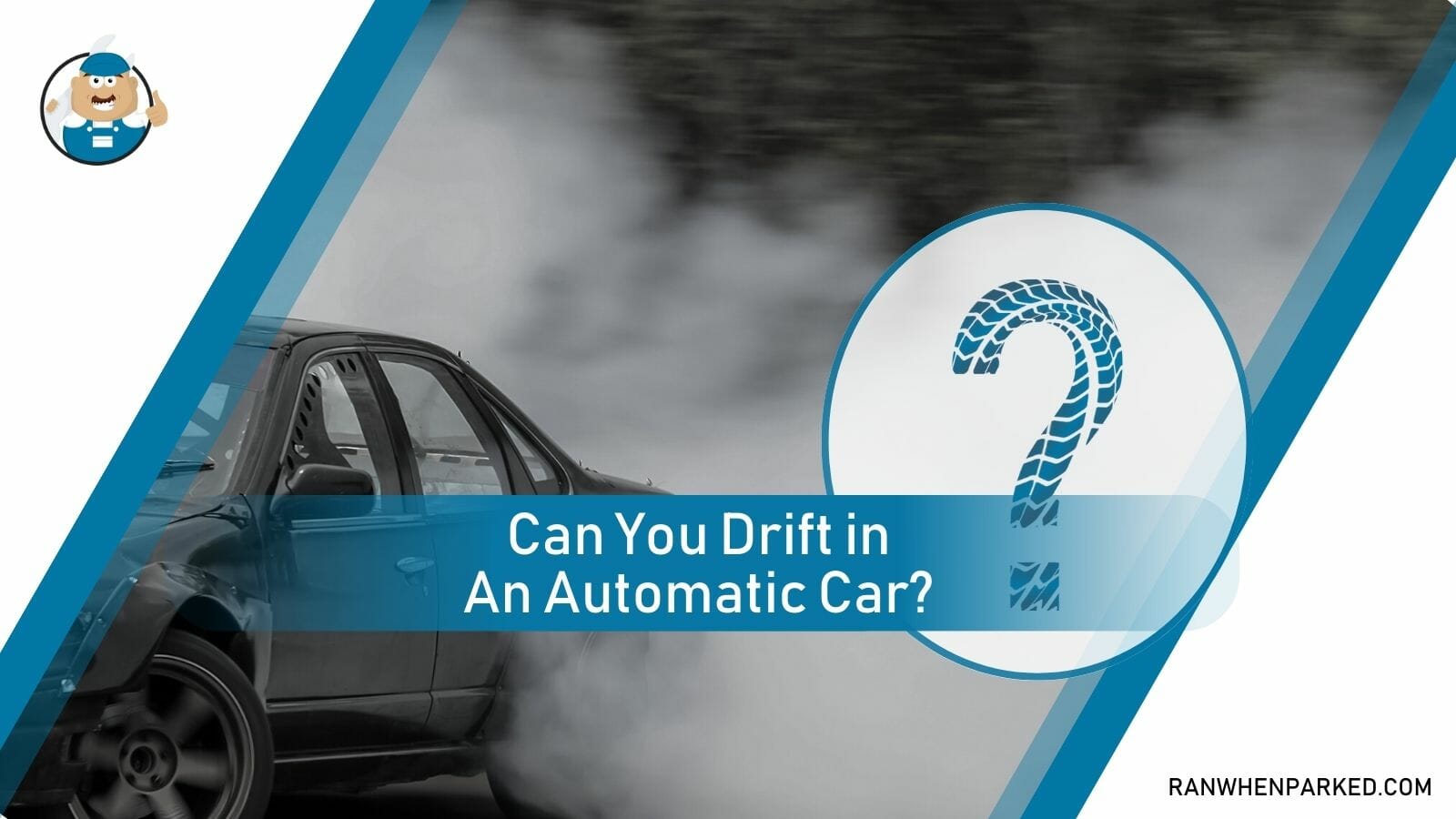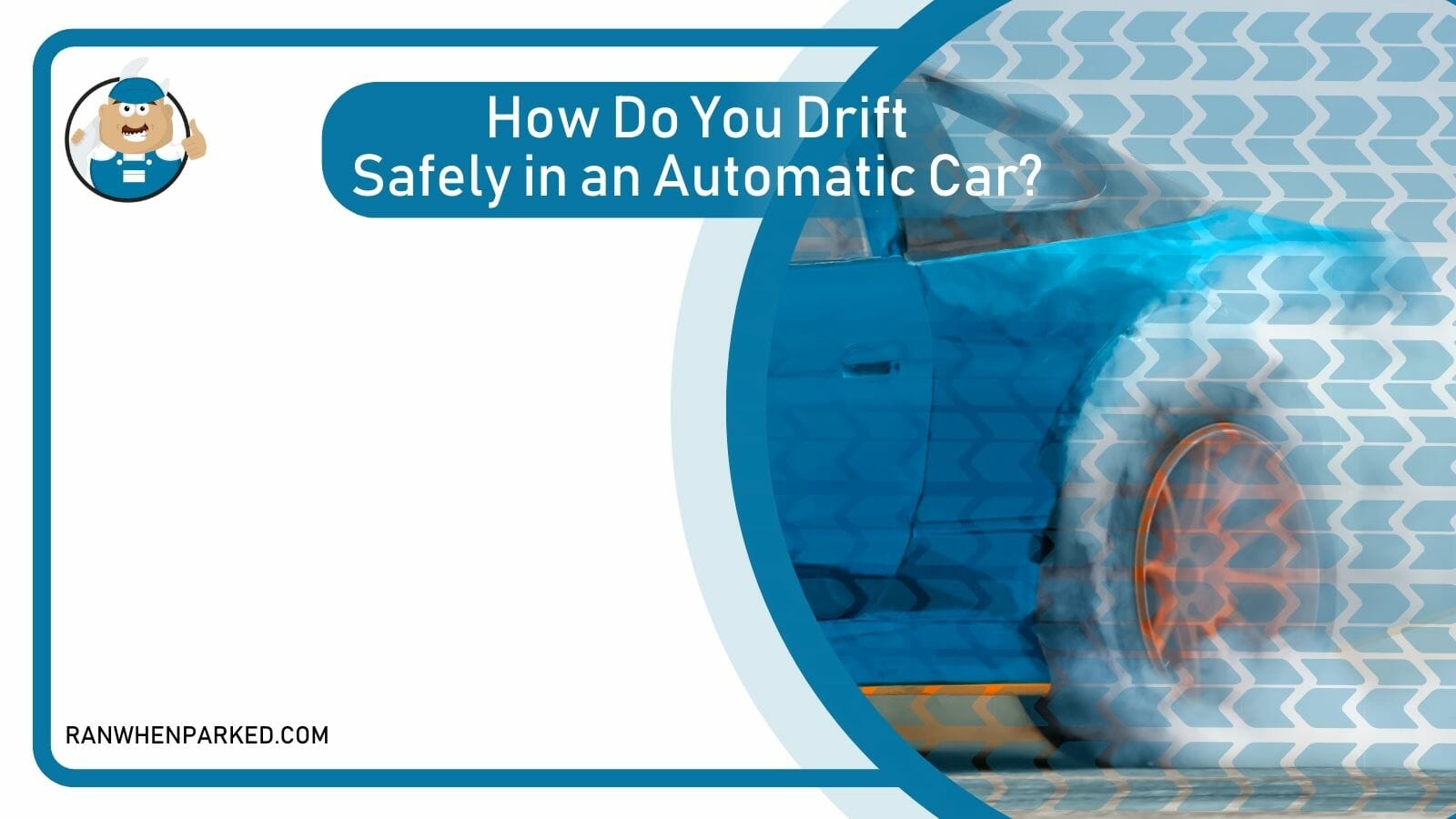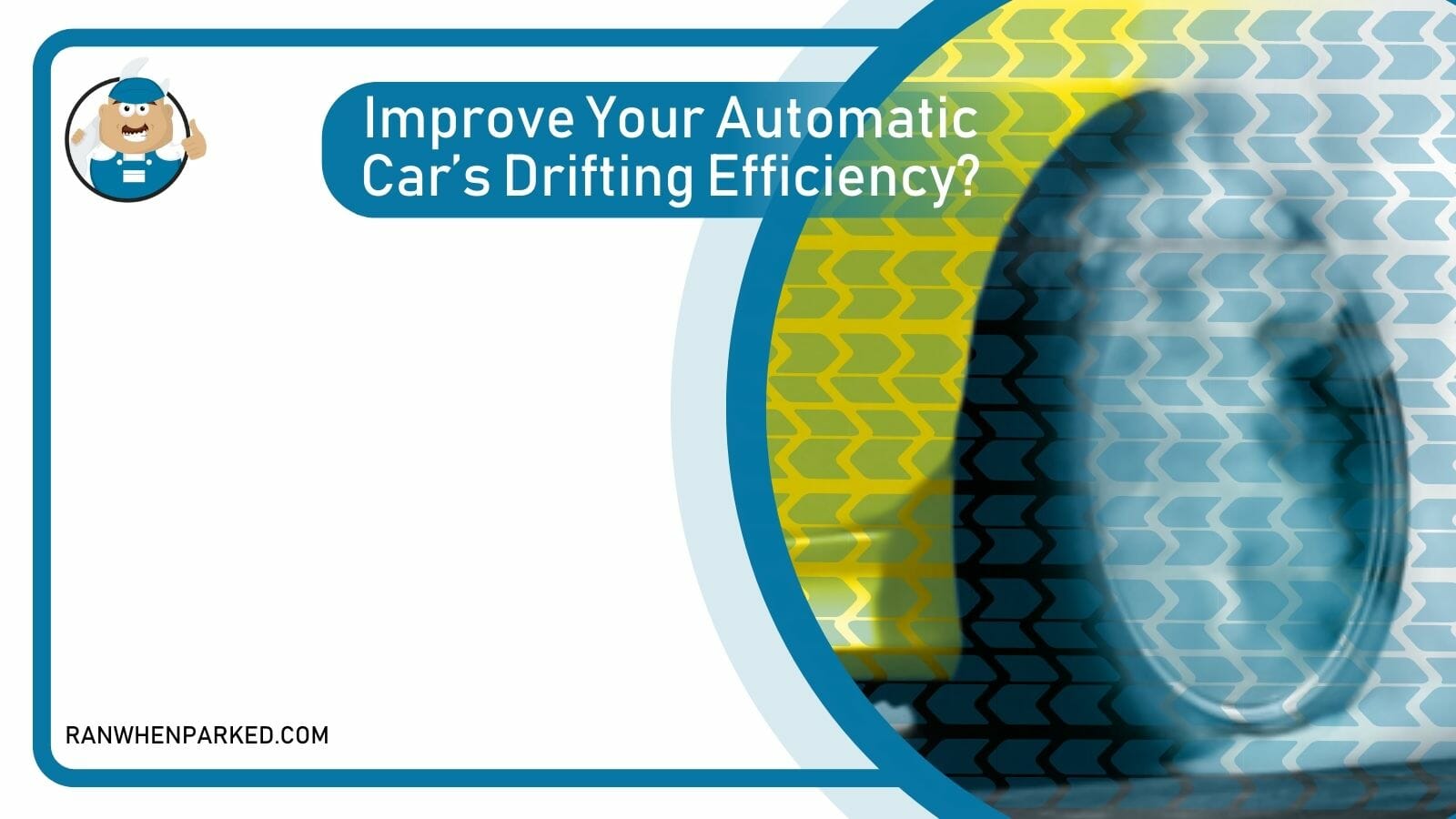“Can you drift in an automatic car?” is a question that probably crosses the minds of motorsports lovers. However, knowing that most vehicles used in these sports are manual, you become curious to see if you can remake the drifting move with your automatic car.

To answer your curiosity, this guide will cover every little detail about drifting and how to perform it with an automatic car, so let’s go!
Is It Possible to Drift in an Automatic Car?
Yes, it is possible to drift in an automatic car. You can drift in any car, whether automatic or manual, as long as you follow the technique; however, the performance can vary. Drifting in an automatic car is not as easy as you would see in manual cars.
This is due to various reasons, one of which is the absence of a clutch. As a result, there is no adequate horsepower; thus, the traction loss is not as fast as that of manual cars. Therefore, drifting an automatic vehicle requires rigorous practice as the driver needs the expertise to avoid losing speed.
Also, an automatic car may require minor modifications to suit the process, because while you can modify the automatic engine, the performance cannot match that of manual racing cars. Generally, cars that drift best have a uniform weight, rear-wheel drive, and a low center of gravity. Some of these cars are specifically made for drifting, called drift cars. For example, Japanese cars are the most sought-after when drifting is a concern.
– Drifting in an Automatic RWD Car
An RWD car is your best bet if you’re considering drifting because they’re the simplest to control. The engines in these cars run the rear wheels, which are the major players in drifting. In some cars, the engine can control only the front wheels or the four wheels; they are called front-wheel-drive and all-wheel-drive cars, respectively.
You can use any of the methods we will mention in this guide to learn how to drift automatic RWD cars.
– Drifting in an Automatic FWD Car
Can you drift in an automatic FWD car? Yes. Although drifting is more suitable with rear-wheel-drive cars, you can still achieve it with front-wheel-drive cars (FWD). However, it would be best if you refrained from drifting with an FWD car as a newbie because you’ll most likely damage it. This is because FWD car drifting is difficult and requires a high level of expertise.

The easiest technique to drift an FWD car is using the handbrake. Pulling the handbrake while steering into a bend locks the rear wheels, causing the car’s rear to step out. Then you can maintain your track by applying the throttle and steering in the correct direction.
Another technique is to use the left-foot braking method. Also, you can drift FWD cars using the lift-off oversteer. Here, you lift your foot off the gas pedal to spread the weight to the car’s front. This technique requires steering and countersteering to achieve the drift.
– Drifting in a Car with All-wheel-drive
Drifting in an all-wheel-drive car is another story, as the technique is somewhat different. For all-wheel drive, the car’s speed plays a vital role because it allows, to a greater or lesser extent, to facilitate the maneuver. In this case, you must trace the turn at an acute angle when acquiring the optimal degree of speed.
Right after, a steering stroke will be necessary, first inwards and then outwards, a fact that will initiate the transversal movement of the car.
Why Is It Difficult to Drift in an Automatic Car?
It is difficult to drift in an automatic car because the absence of a clutch does not give it enough horsepower. In addition, automatic cars don’t have manual gear selection, and most modern automatic vehicles do not have a hand brake.
– Automatic Gear Selection
Ordinarily, optimal drifting is done in low gears. Switching the gears in manual cars is easy as the driver initiates the action. However, gear selection is assisted in automatic cars. While you may still attain low gear by reducing the speed with the brakes, it doesn’t make drifting efficient.
On the flip side, you can improve drifting if the car has paddle shifters. All you need to do is to shift the paddle down to be in low gear while simultaneously accelerating the vehicle. This will help control the car’s speed and wheel traction.
However, automatic transmission vehicles increase the gear when revolutions per minute increase over time to preserve the engine’s integrity. As a result, the car can lose track while drifting.
– No Hand Brake
The hand brake is essential to initiate drifts. However, many automatic transmission cars lack hand brakes, especially modern ones, because they are replaced with foot brakes. As a result, making the car lose traction becomes difficult compared to a manual car with a handbrake. Nevertheless, drifting is still achievable but requires extra effort.
How Do You Drift an Automatic Car With a Hand Brake?
To drift an automatic car with a hand brake, first start the engine and accelerate to about 50 kilometers per hour as you approach the bend. This speed is enough to maneuver while maintaining control of your car. Remember that speed is not the major player here.
While beginners may achieve this with the L gear, many drivers employ the second gear because it gives room for more speed and keeps the engine’s torque in check.
Then press the torque converter’s lock-up clutch and turn the steering wheel into the bend while simultaneously pulling the handbrake. Afterward, push the throttle, press the lock-up clutch button, and steer the wheel toward the direction of the slide.
Take note that the throttle controls the drifting angle, so the strength at which you press the throttle determines how far the car will drift away from the bend.
How Do You Drift an Automatic Car Without a Hand Brake?
To drift an automatic car without a hand brake, you should employ the throttle for speed and apply the brakes upon approaching a bend and steering in the right direction. However, you shouldn’t use the brakes suddenly — use it slowly and continue accelerating as you exit the bend.
Aside from this method, there are other drifting techniques for cars without handbrakes. They include the pendulum pump, left foot brake, and trail braking.
– Pendulum Pump
The pendulum pump is the simplest of the three techniques. Its principle is based on weight transfer, and it’s commonly used in motorsport called rallying. Also, initiating the pendulum pump requires a higher speed than required for cars with handbrakes.
After reaching a certain speed while approaching the curve, steer sharply away from the desired direction and rapidly turn back. At the same time, raise your leg from the throttle. The initial steer causes a weight transfer that helps the car maneuver the curve. After that, accelerate to continue your race.
– Left Foot Brake
Generally, most automatic car users drive with one foot, usually the right foot. However, when there is a need to drift, both feet are needed. The technique involves simultaneously applying the left foot on the break and the right foot on the throttle while approaching a bend. This act is similar to using the handbrake.
Left-foot braking is more applicable in front-wheel drive, and for optimum drifting, the force on the throttle must be greater than that of the brake. As a result, the front wheel steers more rapidly than the rear wheels, causing the rear to slide out.
– Trail Braking
Trail braking seems to be the most difficult method, requiring the highest speed compared to the previous techniques. It is best applied in high-radius curves. In trail braking, you apply the throttle to attain a certain speed. Then upon approaching the bend, you fully apply the brake until you get to the apex and steer in the direction of the bend.
This helps to transfer weight to the front wheels, resulting in an oversteer. After that, gently release the brakes and apply the throttle to continue racing. It is crucial to countersteer while almost exiting the bend because this technique can spin the car if not done correctly.
How Do You Drift Safely in an Automatic Car?
To drift safely in an automatic car, there are various factors to consider such as selecting a suitable car, doing lots of practice, using the right tires, and making sure that car maintenance is strictly up to date. Perform all these steps to safely maneuver a bend.

– Select a Suitable Car
Take note that drifting performance varies among cars, so select one that is suited for such a purpose, preferably a rear-wheel-drive car. Make sure to ask for help from professionals when picking what car to use for drifting.
– Practice
Once you’ve selected the best car, it’s time to practice. As a beginner drifter, it would be best to attempt this in an open space that is void of obstacles, such as what you would find in racing events. This is because you want to avoid accidents and injuries.
When that is settled, learn the drill carefully and don’t rush things. Instead, use the initial phase to understand the car. After you’ve developed confidence, you can try different drifting techniques using obstacles.
Another thing to note is that drifting is not a matter of speed but control. Just maintain an optimum speed and steer in the desired direction. Also, take note that you may panic when you lose control, but you’ll get used to that over time.
– Use the Right Tires
Ensure you have extra tires to fix on your car before training. Ideally, it would be best if you considered using worn-out tires because they have less traction, making you drift easily. If you can’t get four tires, make sure you at least get a pair for the rear wheels.

If changing your tires doesn’t make things easier, you can check your car for steering control or auto stability systems. It would be best to turn off these systems to improve drifting. However, doing so can result in accidents, especially if your control game is weak.
– Safety and Car Maintenance
Never neglect your car’s maintenance. Otherwise, you risk knocking your engine or causing fatal accidents. So before hitting the tracks for your practice, do a complete check of all car parts.
Begin with the engine and check that the oils and coolants are in good condition. Also, check the brakes, tires, and gearbox. These car parts are checked before admission into professional racing events.
Also, as a safety requirement, you should always wear a crash helmet. In addition, a fire extinguisher must be in your car at all times; you should keep it somewhere that is easy to access. Another vital component that must be on your car is the tow hook.
– Precautions for Beginners
While drifting, the driver oversteers the car on purpose such that the rear wheels lose traction and the control of the car rests with the front wheels. In this case, the front wheels face the opposite direction of the bend. Also, in other cases, the front and rear wheels lose traction. Generally, car racers drift to maneuver a curve on the road without hitting obstacles or going off track.
While drifting, the rear wheels raise smoke due to friction with the road, and the car rotates to trace the desired movement path. The rotation may make drifting look dangerous, but it’s just a regular cautious driving technique for expert drivers.
Generally, drivers drift by correctly handling the wheel steering and throttle. The throttle allows the driver to optimally maintain speed during the entry or exit of a curve. On the other hand, the steering directs the drift to keep the car on the track.
Drifting became prevalent as a car competition. In this case, speed doesn’t determine the winner but precision; that is, the driver’s ability to lose traction of the rear wheels without colliding with obstacles or driving outside the racing lane.
While a novice driver would reduce his speed upon approaching a bend, an expert can use the drifting technique to maneuver the turn while maintaining a higher speed. This is because while drifting, the emergency brakes are minimally involved, thus allowing the car to exit a curved lane without losing speed.
There are two things to note before starting to drift as a beginner. First, it’s a maneuver that damages the rear tires a lot. If performed frequently, it will lead to tire wear. Another observation to make concerns safety. You could hit walls or obstacles if you don’t know how to handle the car well. Hence, go to large empty spaces with little to no traffic.
How Do You Improve Your Automatic Car’s Drifting Efficiency?
To improve your automatic car’s drifting efficiency, there are a few modifications to make such as acquiring high-performance tires, upgrading your car’s suspension, switching to a hydraulic handbrake, and installing an angle kit. These modifications will help make your automatic car more suitable for drifting.

– Tires
First, change your tires to high-performance types. This is because they have excellent grip and are responsive. Another thing to consider is introducing a limited-slip differential. It’s a traction aid that makes the wheels drift at different speeds, especially on surfaces without a good grip.
– Suspension
In addition, you should upgrade your car’s suspension. This will improve your tire’s grip, especially when drifting high-radius bends at high speeds.
– Handbrake
Another notable modification is the handbrake. Mechanical handbrake cables tend to lose functionality after repeated engagement, so this handbrake is not your best bet if you want to consider drifting.
Switching from a mechanical pull-handbrake to a hydraulic model helps to improve mechanical advantages. Therefore, it is easier to lock the rear wheels to trigger drifting. Also, hydraulic handbrakes are positioned such that they are easily accessible.
– Angle Kit
The angle kit is another interesting modification you can make on your automatic car. This is because it enables you to do the unthinkable and steer optimally at steep bends.
Keep in mind that the above suggestions can be costly, so they may only be necessary if you want to take drifting to a professional level. Aside from this, you can remain consistent with your practice, get used to your car’s details, and be perfect over time.
Frequently Asked Questions
1. Does Drifting Spoil My Automatic Car?
Yes, drifting can spoil your automatic car and cause many faults. The most common damage is wear and tear on the wheels and tires due to friction with the track or collision with obstacles. You probably have noticed black spots on racing tracks; this is the tire’s skin peeling.
Over time, the tires get weaker and lose their shape, thus needing replacement. In addition, your car’s brakes and suspension can be faulty due to consistent and poor drifting techniques. The brake pads can get overheated, and some bolts and nuts can become loose, limiting the car’s efficiency and resulting in brake failure.
2. Are There Special Automatic Cars for Drifting?
No, there are no special automatic cars for drifting and you can do it with practically any car that is available. However, the ease of drifting varies across vehicles. It is best to select an RWD car for a more pleasant experience.
In addition, manual transmission vehicles offer the best drifting performances because you control every activity that initiates and maintains drifting. Regardless of the kind of car you use, it is essential to practice consistently and gain a high confidence level before hitting the racing tracks.
3. Do I Need a Legal Document to Drift in an Automatic Car?
No, you don’t need a legal document to drift in an automatic or manual car. However, you must have a valid driver’s license to drive any car. Also, take driving training from professionals to understand automatic and manual car models.
After successfully training, you can then begin personal practice in open spaces that are void of traffic and obstacles.
Conclusion
Drifting is a prevalent technique among car racers as they maneuver corners on the tracks, but this technique is more popular among manual car owners. If you have read this far, you should know that you can also drift with an automatic motor vehicle, so here are the points to note from this guide:
- Yes, you can drift in an automatic car, but it’s more complicated than in manual cars.
- You can modify your automatic car to improve drifting.
- It is more difficult to drift in an automatic car because the absence of a clutch does not give it enough horsepower.
- Rear-wheel-drive cars are best suited for drifting.
While drifting may seem exciting, don’t get carried away by neglecting your safety. Therefore, remember to follow all precautions in this guide and maintain your vehicle for a pleasant experience.
- Best Exhaust Tip for Deep Sound: Top Picks for 2025 - May 3, 2025
- Best Clear Coat for Headlights Reviewed: Top Picks for Enhanced Visibility - May 3, 2025
- Best Car Coffee Table Books for Auto Enthusiasts - May 3, 2025